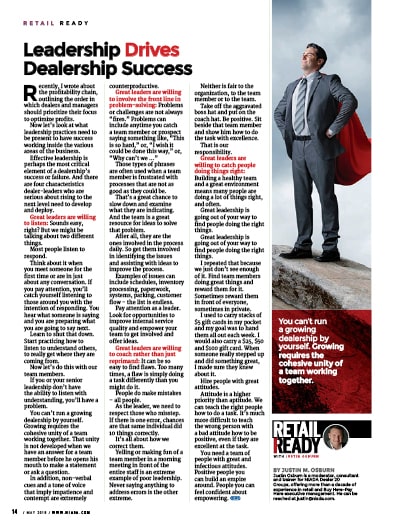Leadership Drives Dealership Success
Recently, I wrote about the profitability chain, outlining the order in which dealers and managers should prioritize their focus to optimize profits. Now let’s look at what leadership practices need to be present to have success working inside the various areas of the business.
Effective leadership is perhaps the most critical element of a dealership’s success or failure. And there are four characteristics dealer-leaders who are serious about rising to the next level need to develop and deploy.
Great leaders are willing to listen:
Sounds easy, right? But we might be talking about two different things. Most people listen to respond.
Think about it when you meet someone for the first time or are in just about any conversation. If you pay attention, you’ll catch yourself listening to those around you with the intention of responding. You hear what someone is saying and you are preparing what you are going to say next. Learn to shut that down. Start practicing how to listen to understand others, to really get where they are coming from. Now let’s do this with our team members. If you or your senior leadership don’t have
the ability to listen with understanding, you’ll have a problem. You can’t run a growing dealership by yourself. Growing requires the cohesive unity of a team working together. That unity is not developed when we have an answer for a team member before he opens his mouth to make a statement or ask a question. In addition, non-verbal cues and a tone of voice that imply impatience and contempt are extremely counterproductive.
Great leaders are willing to involve the front line in problem-solving:
Problems or challenges are not always “fires.” Problems can include anytime you catch a team member or prospect saying something like, “This is so hard,” or, “I wish it could be done this way,” or, “Why can’t we ...”
Those types of phrases are often used when a team member is frustrated with processes that are not as good as they could be. That’s a great chance to slow down and examine what they are indicating. And the team is a great resource for ideas to solve that problem. After all, they are the ones involved in the process daily. So get them involved in identifying the issues and assisting with ideas to improve the process. Examples of issues can include schedules, inventory processing, paperwork, systems, parking, customer flow – the list is endless. Pay attention as a leader. Look for opportunities to improve internal service quality and empower your team to get involved and offer ideas.
Great leaders are willing to coach rather than just reprimand:
It can be so easy to find flaws. Too many times, a flaw is simply doing a task differently than you might do it.
People do make mistakes – all people. As the leader, we need to respect those who misstep. If there is one error, chances are that same individual did 10 things correctly. It’s all about how we correct them. Yelling or making fun of a team member in a morning meeting in front of the entire staff is an extreme example of poor leadership. Never saying anything to address errors is the other extreme. Neither is fair to the organization, to the team member or to the team. Take off the aggravated boss hat and put on the coach hat. Be positive. Sit beside that team member and show him how to do the task with excellence. That is our responsibility.
Great leaders are willing to catch people doing things right:
Building a healthy team and a great environment means many people are doing a lot of things right, and often. Great leadership is going out of your way to find people doing the right things. Great leadership is going out of your way to find people doing the right things. I repeated that because we just don’t see enough of it. Find team members doing great things and reward them for it. Sometimes reward them in front of everyone, sometimes in private. I used to carry stacks of $5 gift cards in my pocket and my goal was to hand them all out each week. I would also carry a $25, $50 and $100 gift card. When someone really stepped up and did something great, I made sure they knew about it. Hire people with great attitudes. Attitude is a higher priority than aptitude. We can teach the right people how to do a task. It’s much more difficult to teach the wrong person with a bad attitude how to be positive, even if they are excellent at the task.
You need a team of people with great and infectious attitudes. Positive people you can build an empire around. People you can feel confident about empowering.

